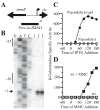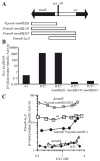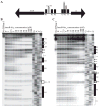Identification and characterization of the immunity repressor (ImmR) that controls the mobile genetic element ICEBs1 of Bacillus subtilis
- PMID: 17511812
- PMCID: PMC3320793
- DOI: 10.1111/j.1365-2958.2007.05748.x
Identification and characterization of the immunity repressor (ImmR) that controls the mobile genetic element ICEBs1 of Bacillus subtilis
Abstract
ICEBs1 is a mobile genetic element found in the chromosome of Bacillus subtilis. Excision and transfer of ICEBs1 is regulated by the global DNA damage response and intercellular peptide signalling. We identified and characterized a repressor, ImmR (formerly YdcN), encoded by ICEBs1. ImmR represses transcription of genes required for excision and transfer, and both activates and represses its own transcription. ImmR regulates transcription within ICEBs1 by binding to several sites in the region of DNA that contains promoters for both immR and xis (encoding excisionase). In addition, we found that ImmR confers immunity from acquisition of additional copies of ICEBs1. ImmR-mediated regulation serves to keep a single copy of ICEBs1 stably maintained in the absence of induction, allows a rapid response to inducing signals, and helps limit acquisition of additional copies of ICEBs1.
Figures






References
-
- Bailey TL, Elkan C. Fitting a mixture model by expectation maximization to discover motifs in biopolymers. Proc Int Conf Intell Syst Mol Biol. 1994;2:28–36. - PubMed
-
- Bailey TL, Gribskov M. Combining evidence using p-values: application to sequence homology searches. Bioinformatics. 1998;14:48–54. - PubMed
Publication types
MeSH terms
Substances
Grants and funding
LinkOut - more resources
Full Text Sources
Other Literature Sources
Molecular Biology Databases

